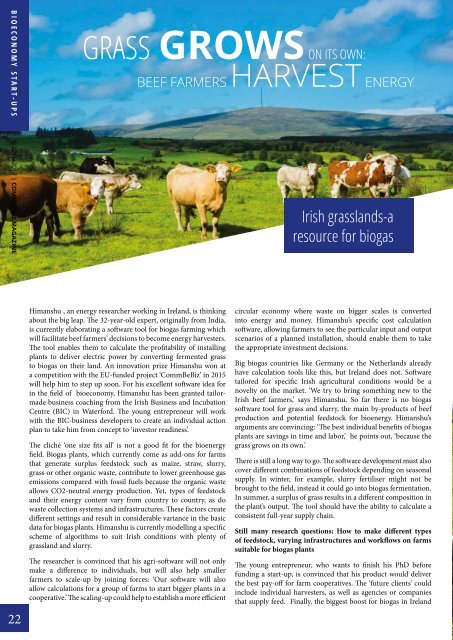BE INNOVATION_commbebiz-magazine 2016_2017
You also want an ePaper? Increase the reach of your titles
YUMPU automatically turns print PDFs into web optimized ePapers that Google loves.
BIOECONOMY START-UPS<br />
GRASS GROWS ON ITS OWN:<br />
<strong>BE</strong>EF FARMERS HARVEST ENERGY<br />
<strong>2016</strong>-<strong>2017</strong> | COMM<strong>BE</strong>BIZ MAGAZINE<br />
Irish grasslands-a<br />
resource for biogas<br />
22<br />
Himanshu , an energy researcher working in Ireland, is thinking<br />
about the big leap. The 32-year-old expert, originally from India,<br />
is currently elaborating a software tool for biogas farming which<br />
will facilitate beef farmers’ decisions to become energy harvesters.<br />
The tool enables them to calculate the profitability of installing<br />
plants to deliver electric power by converting fermented grass<br />
to biogas on their land. An innovation prize Himanshu won at<br />
a competition with the EU-funded project ‘CommBeBiz’ in 2015<br />
will help him to step up soon. For his excellent software idea for<br />
in the field of bioeconomy, Himanshu has been granted tailormade<br />
business coaching from the Irish Business and Incubation<br />
Centre (BIC) in Waterford. The young entrepreneur will work<br />
with the BIC-business developers to create an individual action<br />
plan to take him from concept to ‘investor readiness’.<br />
The cliché ‘one size fits all’ is not a good fit for the bioenergy<br />
field. Biogas plants, which currently come as add-ons for farms<br />
that generate surplus feedstock such as maize, straw, slurry,<br />
grass or other organic waste, contribute to lower greenhouse gas<br />
emissions compared with fossil fuels because the organic waste<br />
allows CO2-neutral energy production. Yet, types of feedstock<br />
and their energy content vary from country to country, as do<br />
waste collection systems and infrastructures. These factors create<br />
different settings and result in considerable variance in the basic<br />
data for biogas plants. Himanshu is currently modelling a specific<br />
scheme of algorithms to suit Irish conditions with plenty of<br />
grassland and slurry.<br />
The researcher is convinced that his agri-software will not only<br />
make a difference to individuals, but will also help smaller<br />
farmers to scale-up by joining forces: ‘Our software will also<br />
allow calculations for a group of farms to start bigger plants in a<br />
cooperative.’ The scaling-up could help to establish a more efficient<br />
circular economy where waste on bigger scales is converted<br />
into energy and money. Himanshu’s specific cost calculation<br />
software, allowing farmers to see the particular input and output<br />
scenarios of a planned installation, should enable them to take<br />
the appropriate investment decisions.<br />
Big biogas countries like Germany or the Netherlands already<br />
have calculation tools like this, but Ireland does not. Software<br />
tailored for specific Irish agricultural conditions would be a<br />
novelty on the market. ‘We try to bring something new to the<br />
Irish beef farmers,’ says Himanshu. So far there is no biogas<br />
software tool for grass and slurry, the main by-products of beef<br />
production and potential feedstock for bioenergy. Himanshu’s<br />
arguments are convincing: ‘The best individual benefits of biogas<br />
plants are savings in time and labor,’ he points out, ‘because the<br />
grass grows on its own.’<br />
There is still a long way to go. The software development must also<br />
cover different combinations of feedstock depending on seasonal<br />
supply. In winter, for example, slurry fertiliser might not be<br />
brought to the field, instead it could go into biogas fermentation.<br />
In summer, a surplus of grass results in a different composition in<br />
the plant’s output. The tool should have the ability to calculate a<br />
consistent full-year supply chain.<br />
Still many research questions: How to make different types<br />
of feedstock, varying infrastructures and workflows on farms<br />
suitable for biogas plants<br />
The young entrepreneur, who wants to finish his PhD before<br />
funding a start-up, is convinced that his product would deliver<br />
the best pay-off for farm cooperatives. The ‘future clients’ could<br />
include individual harvesters, as well as agencies or companies<br />
that supply feed. Finally, the biggest boost for biogas in Ireland


